Financial Performance Management Report: Environmental Costs
VerifiedAdded on 2023/01/04
|13
|4049
|20
Report
AI Summary
This report delves into the intricacies of financial performance management, focusing on the critical aspects of environmental costs and the strategic incorporation of management accounting planning tools. The first section provides a detailed examination of the issues businesses face when managing environmental costs, exploring various accounting methods used to address these challenges. It includes a discussion on environmental risk assessment, checklist matrices, and other techniques. The second part of the report discusses the integration of management accounting planning tools, such as zero-based budgeting, activity-based budgeting, and budgetary control, to solve financial problems. It evaluates the impact of these tools on a business's financial performance and its ability to achieve financial sustainability. The report also covers the importance of financial decision-making, the process involved, and the various tools used in management accounting planning. The report concludes with a summary of the key findings and implications for effective financial management.
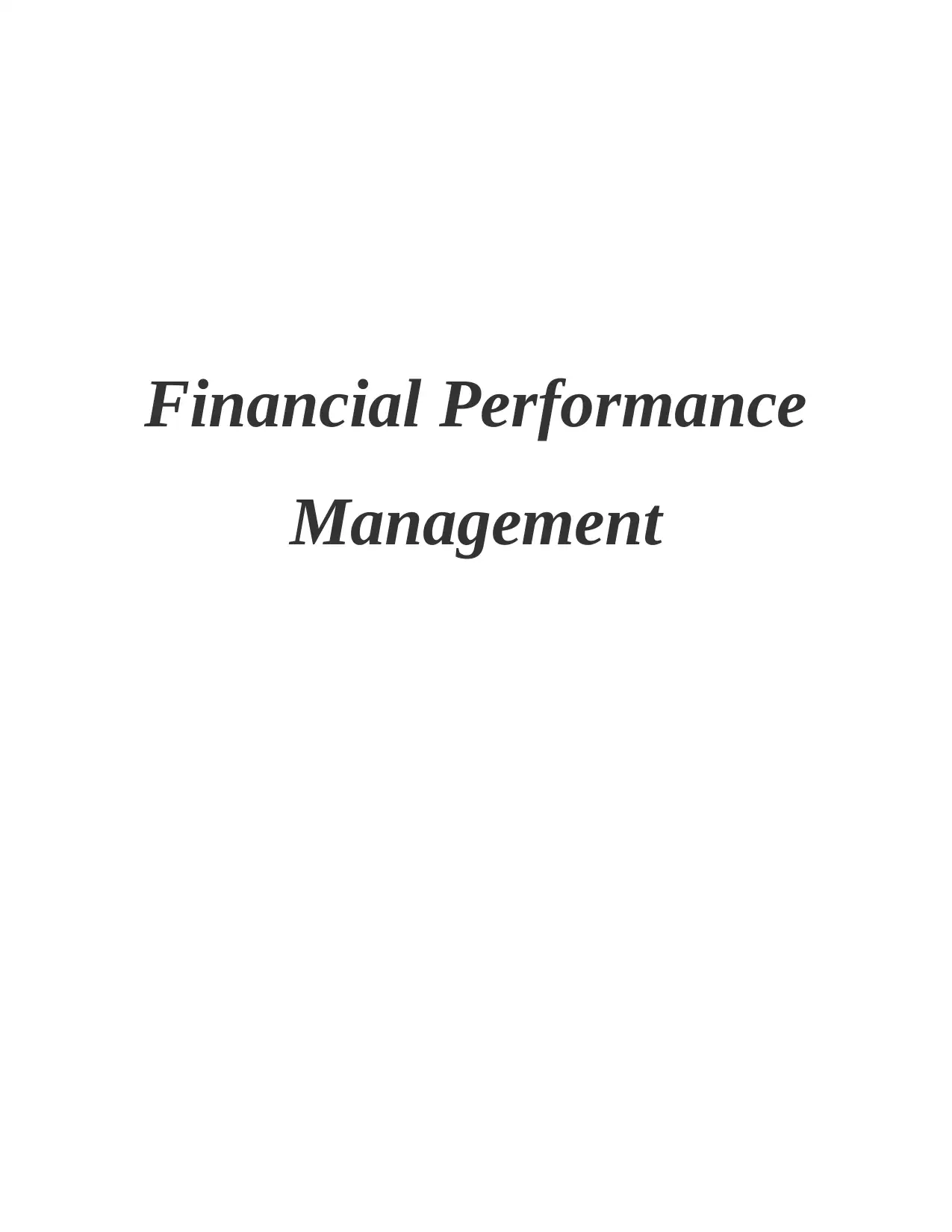
Financial Performance
Management
Management
Paraphrase This Document
Need a fresh take? Get an instant paraphrase of this document with our AI Paraphraser
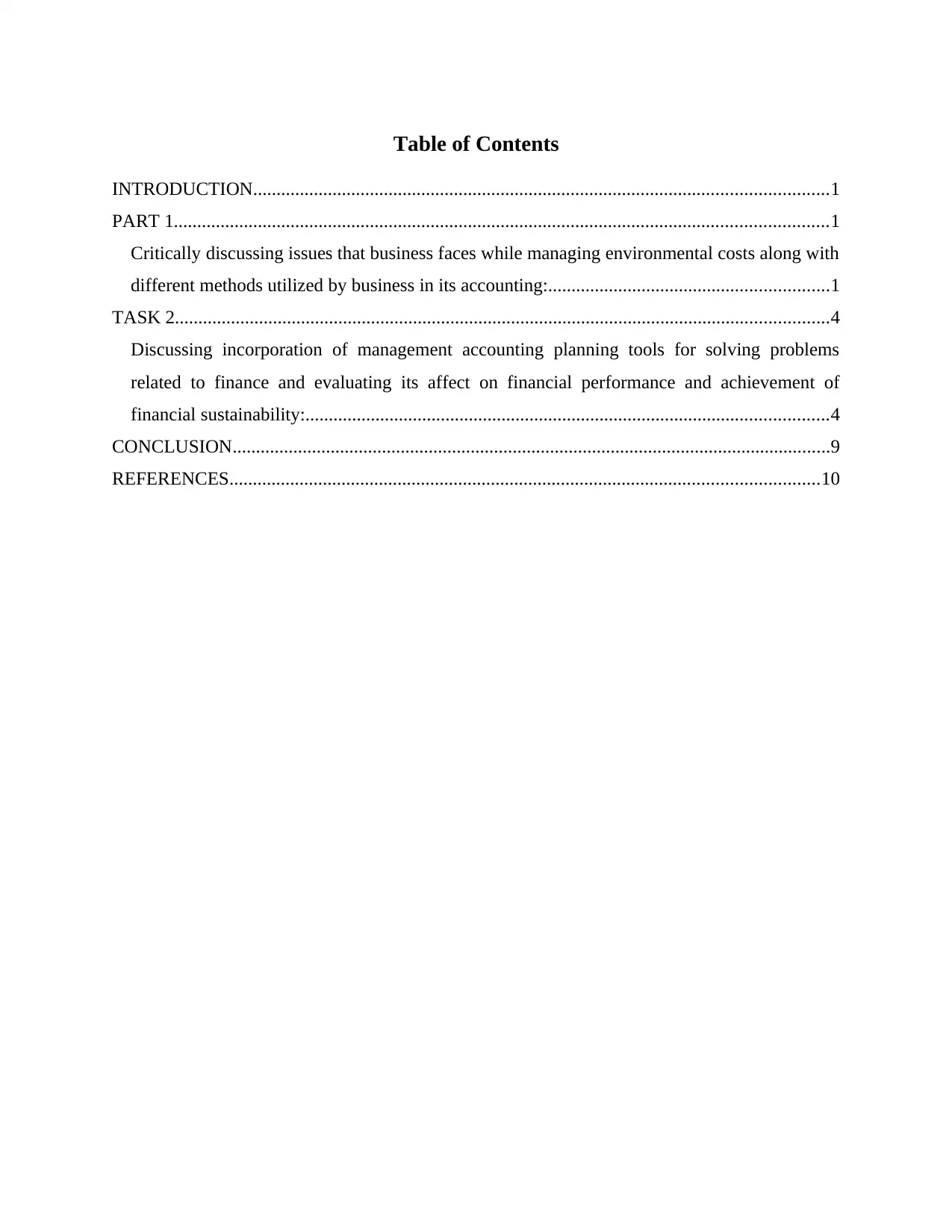
Table of Contents
INTRODUCTION...........................................................................................................................1
PART 1............................................................................................................................................1
Critically discussing issues that business faces while managing environmental costs along with
different methods utilized by business in its accounting:............................................................1
TASK 2............................................................................................................................................4
Discussing incorporation of management accounting planning tools for solving problems
related to finance and evaluating its affect on financial performance and achievement of
financial sustainability:................................................................................................................4
CONCLUSION................................................................................................................................9
REFERENCES..............................................................................................................................10
INTRODUCTION...........................................................................................................................1
PART 1............................................................................................................................................1
Critically discussing issues that business faces while managing environmental costs along with
different methods utilized by business in its accounting:............................................................1
TASK 2............................................................................................................................................4
Discussing incorporation of management accounting planning tools for solving problems
related to finance and evaluating its affect on financial performance and achievement of
financial sustainability:................................................................................................................4
CONCLUSION................................................................................................................................9
REFERENCES..............................................................................................................................10
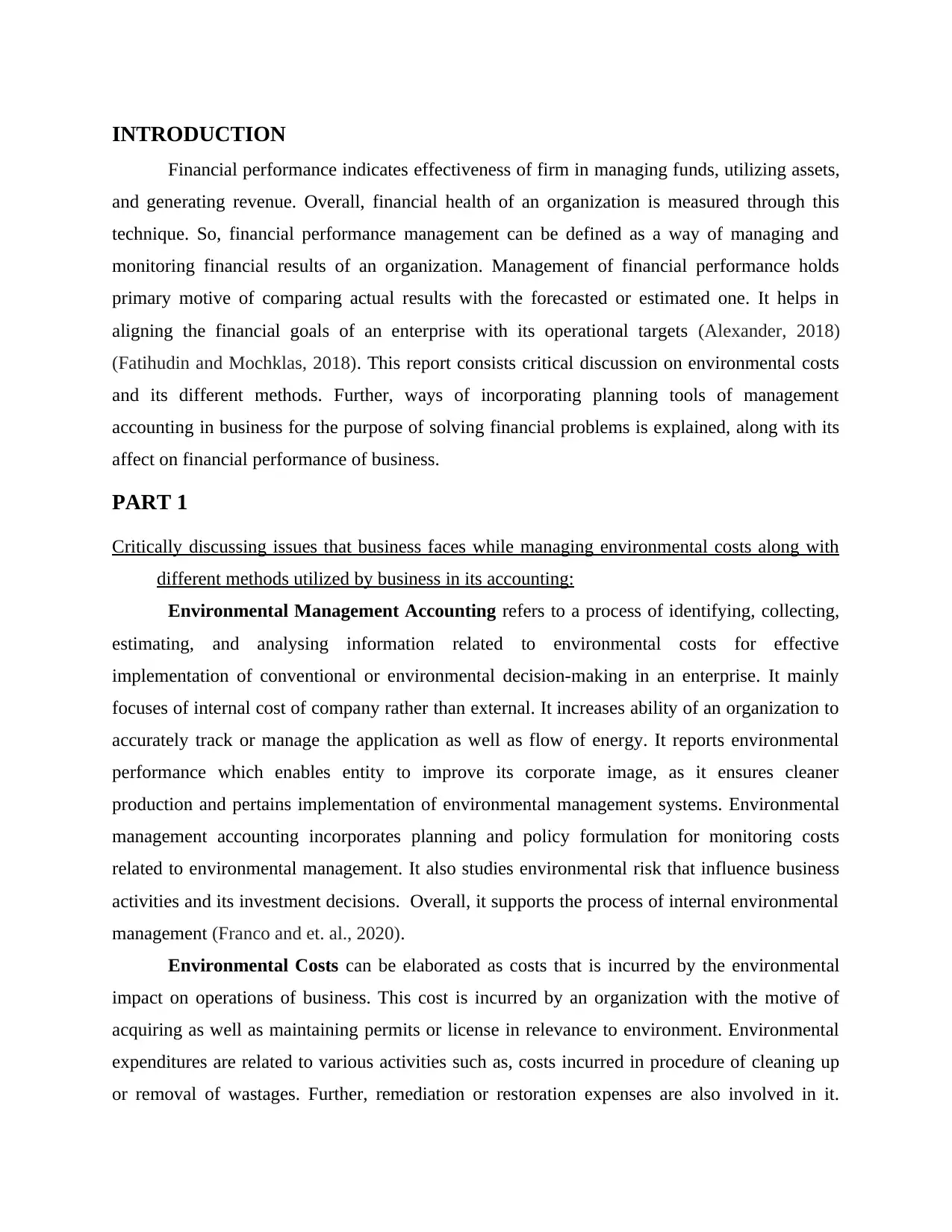
INTRODUCTION
Financial performance indicates effectiveness of firm in managing funds, utilizing assets,
and generating revenue. Overall, financial health of an organization is measured through this
technique. So, financial performance management can be defined as a way of managing and
monitoring financial results of an organization. Management of financial performance holds
primary motive of comparing actual results with the forecasted or estimated one. It helps in
aligning the financial goals of an enterprise with its operational targets (Alexander, 2018)
(Fatihudin and Mochklas, 2018). This report consists critical discussion on environmental costs
and its different methods. Further, ways of incorporating planning tools of management
accounting in business for the purpose of solving financial problems is explained, along with its
affect on financial performance of business.
PART 1
Critically discussing issues that business faces while managing environmental costs along with
different methods utilized by business in its accounting:
Environmental Management Accounting refers to a process of identifying, collecting,
estimating, and analysing information related to environmental costs for effective
implementation of conventional or environmental decision-making in an enterprise. It mainly
focuses of internal cost of company rather than external. It increases ability of an organization to
accurately track or manage the application as well as flow of energy. It reports environmental
performance which enables entity to improve its corporate image, as it ensures cleaner
production and pertains implementation of environmental management systems. Environmental
management accounting incorporates planning and policy formulation for monitoring costs
related to environmental management. It also studies environmental risk that influence business
activities and its investment decisions. Overall, it supports the process of internal environmental
management (Franco and et. al., 2020).
Environmental Costs can be elaborated as costs that is incurred by the environmental
impact on operations of business. This cost is incurred by an organization with the motive of
acquiring as well as maintaining permits or license in relevance to environment. Environmental
expenditures are related to various activities such as, costs incurred in procedure of cleaning up
or removal of wastages. Further, remediation or restoration expenses are also involved in it.
Financial performance indicates effectiveness of firm in managing funds, utilizing assets,
and generating revenue. Overall, financial health of an organization is measured through this
technique. So, financial performance management can be defined as a way of managing and
monitoring financial results of an organization. Management of financial performance holds
primary motive of comparing actual results with the forecasted or estimated one. It helps in
aligning the financial goals of an enterprise with its operational targets (Alexander, 2018)
(Fatihudin and Mochklas, 2018). This report consists critical discussion on environmental costs
and its different methods. Further, ways of incorporating planning tools of management
accounting in business for the purpose of solving financial problems is explained, along with its
affect on financial performance of business.
PART 1
Critically discussing issues that business faces while managing environmental costs along with
different methods utilized by business in its accounting:
Environmental Management Accounting refers to a process of identifying, collecting,
estimating, and analysing information related to environmental costs for effective
implementation of conventional or environmental decision-making in an enterprise. It mainly
focuses of internal cost of company rather than external. It increases ability of an organization to
accurately track or manage the application as well as flow of energy. It reports environmental
performance which enables entity to improve its corporate image, as it ensures cleaner
production and pertains implementation of environmental management systems. Environmental
management accounting incorporates planning and policy formulation for monitoring costs
related to environmental management. It also studies environmental risk that influence business
activities and its investment decisions. Overall, it supports the process of internal environmental
management (Franco and et. al., 2020).
Environmental Costs can be elaborated as costs that is incurred by the environmental
impact on operations of business. This cost is incurred by an organization with the motive of
acquiring as well as maintaining permits or license in relevance to environment. Environmental
expenditures are related to various activities such as, costs incurred in procedure of cleaning up
or removal of wastages. Further, remediation or restoration expenses are also involved in it.
⊘ This is a preview!⊘
Do you want full access?
Subscribe today to unlock all pages.

Trusted by 1+ million students worldwide
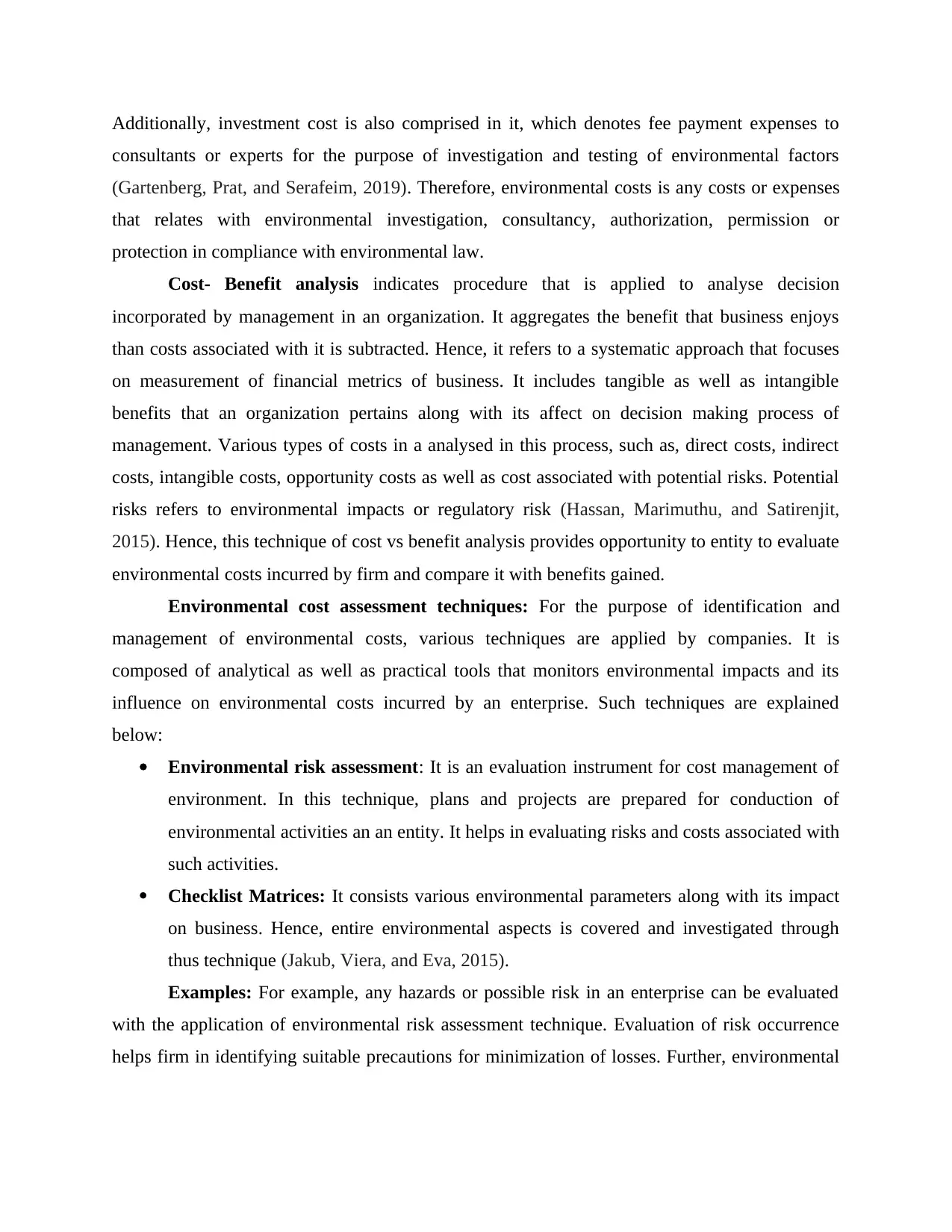
Additionally, investment cost is also comprised in it, which denotes fee payment expenses to
consultants or experts for the purpose of investigation and testing of environmental factors
(Gartenberg, Prat, and Serafeim, 2019). Therefore, environmental costs is any costs or expenses
that relates with environmental investigation, consultancy, authorization, permission or
protection in compliance with environmental law.
Cost- Benefit analysis indicates procedure that is applied to analyse decision
incorporated by management in an organization. It aggregates the benefit that business enjoys
than costs associated with it is subtracted. Hence, it refers to a systematic approach that focuses
on measurement of financial metrics of business. It includes tangible as well as intangible
benefits that an organization pertains along with its affect on decision making process of
management. Various types of costs in a analysed in this process, such as, direct costs, indirect
costs, intangible costs, opportunity costs as well as cost associated with potential risks. Potential
risks refers to environmental impacts or regulatory risk (Hassan, Marimuthu, and Satirenjit,
2015). Hence, this technique of cost vs benefit analysis provides opportunity to entity to evaluate
environmental costs incurred by firm and compare it with benefits gained.
Environmental cost assessment techniques: For the purpose of identification and
management of environmental costs, various techniques are applied by companies. It is
composed of analytical as well as practical tools that monitors environmental impacts and its
influence on environmental costs incurred by an enterprise. Such techniques are explained
below:
Environmental risk assessment: It is an evaluation instrument for cost management of
environment. In this technique, plans and projects are prepared for conduction of
environmental activities an an entity. It helps in evaluating risks and costs associated with
such activities.
Checklist Matrices: It consists various environmental parameters along with its impact
on business. Hence, entire environmental aspects is covered and investigated through
thus technique (Jakub, Viera, and Eva, 2015).
Examples: For example, any hazards or possible risk in an enterprise can be evaluated
with the application of environmental risk assessment technique. Evaluation of risk occurrence
helps firm in identifying suitable precautions for minimization of losses. Further, environmental
consultants or experts for the purpose of investigation and testing of environmental factors
(Gartenberg, Prat, and Serafeim, 2019). Therefore, environmental costs is any costs or expenses
that relates with environmental investigation, consultancy, authorization, permission or
protection in compliance with environmental law.
Cost- Benefit analysis indicates procedure that is applied to analyse decision
incorporated by management in an organization. It aggregates the benefit that business enjoys
than costs associated with it is subtracted. Hence, it refers to a systematic approach that focuses
on measurement of financial metrics of business. It includes tangible as well as intangible
benefits that an organization pertains along with its affect on decision making process of
management. Various types of costs in a analysed in this process, such as, direct costs, indirect
costs, intangible costs, opportunity costs as well as cost associated with potential risks. Potential
risks refers to environmental impacts or regulatory risk (Hassan, Marimuthu, and Satirenjit,
2015). Hence, this technique of cost vs benefit analysis provides opportunity to entity to evaluate
environmental costs incurred by firm and compare it with benefits gained.
Environmental cost assessment techniques: For the purpose of identification and
management of environmental costs, various techniques are applied by companies. It is
composed of analytical as well as practical tools that monitors environmental impacts and its
influence on environmental costs incurred by an enterprise. Such techniques are explained
below:
Environmental risk assessment: It is an evaluation instrument for cost management of
environment. In this technique, plans and projects are prepared for conduction of
environmental activities an an entity. It helps in evaluating risks and costs associated with
such activities.
Checklist Matrices: It consists various environmental parameters along with its impact
on business. Hence, entire environmental aspects is covered and investigated through
thus technique (Jakub, Viera, and Eva, 2015).
Examples: For example, any hazards or possible risk in an enterprise can be evaluated
with the application of environmental risk assessment technique. Evaluation of risk occurrence
helps firm in identifying suitable precautions for minimization of losses. Further, environmental
Paraphrase This Document
Need a fresh take? Get an instant paraphrase of this document with our AI Paraphraser
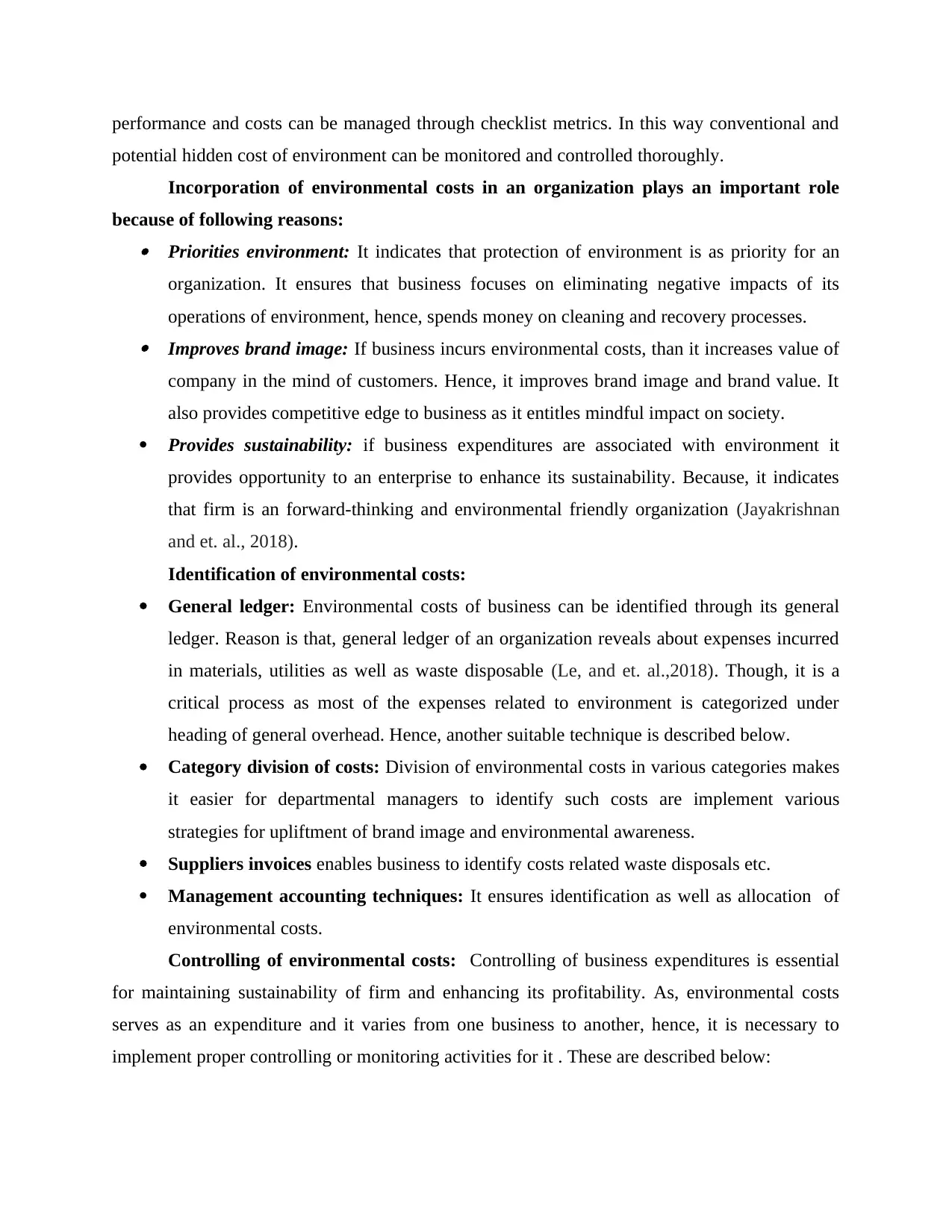
performance and costs can be managed through checklist metrics. In this way conventional and
potential hidden cost of environment can be monitored and controlled thoroughly.
Incorporation of environmental costs in an organization plays an important role
because of following reasons: Priorities environment: It indicates that protection of environment is as priority for an
organization. It ensures that business focuses on eliminating negative impacts of its
operations of environment, hence, spends money on cleaning and recovery processes. Improves brand image: If business incurs environmental costs, than it increases value of
company in the mind of customers. Hence, it improves brand image and brand value. It
also provides competitive edge to business as it entitles mindful impact on society.
Provides sustainability: if business expenditures are associated with environment it
provides opportunity to an enterprise to enhance its sustainability. Because, it indicates
that firm is an forward-thinking and environmental friendly organization (Jayakrishnan
and et. al., 2018).
Identification of environmental costs:
General ledger: Environmental costs of business can be identified through its general
ledger. Reason is that, general ledger of an organization reveals about expenses incurred
in materials, utilities as well as waste disposable (Le, and et. al.,2018). Though, it is a
critical process as most of the expenses related to environment is categorized under
heading of general overhead. Hence, another suitable technique is described below.
Category division of costs: Division of environmental costs in various categories makes
it easier for departmental managers to identify such costs are implement various
strategies for upliftment of brand image and environmental awareness.
Suppliers invoices enables business to identify costs related waste disposals etc.
Management accounting techniques: It ensures identification as well as allocation of
environmental costs.
Controlling of environmental costs: Controlling of business expenditures is essential
for maintaining sustainability of firm and enhancing its profitability. As, environmental costs
serves as an expenditure and it varies from one business to another, hence, it is necessary to
implement proper controlling or monitoring activities for it . These are described below:
potential hidden cost of environment can be monitored and controlled thoroughly.
Incorporation of environmental costs in an organization plays an important role
because of following reasons: Priorities environment: It indicates that protection of environment is as priority for an
organization. It ensures that business focuses on eliminating negative impacts of its
operations of environment, hence, spends money on cleaning and recovery processes. Improves brand image: If business incurs environmental costs, than it increases value of
company in the mind of customers. Hence, it improves brand image and brand value. It
also provides competitive edge to business as it entitles mindful impact on society.
Provides sustainability: if business expenditures are associated with environment it
provides opportunity to an enterprise to enhance its sustainability. Because, it indicates
that firm is an forward-thinking and environmental friendly organization (Jayakrishnan
and et. al., 2018).
Identification of environmental costs:
General ledger: Environmental costs of business can be identified through its general
ledger. Reason is that, general ledger of an organization reveals about expenses incurred
in materials, utilities as well as waste disposable (Le, and et. al.,2018). Though, it is a
critical process as most of the expenses related to environment is categorized under
heading of general overhead. Hence, another suitable technique is described below.
Category division of costs: Division of environmental costs in various categories makes
it easier for departmental managers to identify such costs are implement various
strategies for upliftment of brand image and environmental awareness.
Suppliers invoices enables business to identify costs related waste disposals etc.
Management accounting techniques: It ensures identification as well as allocation of
environmental costs.
Controlling of environmental costs: Controlling of business expenditures is essential
for maintaining sustainability of firm and enhancing its profitability. As, environmental costs
serves as an expenditure and it varies from one business to another, hence, it is necessary to
implement proper controlling or monitoring activities for it . These are described below:
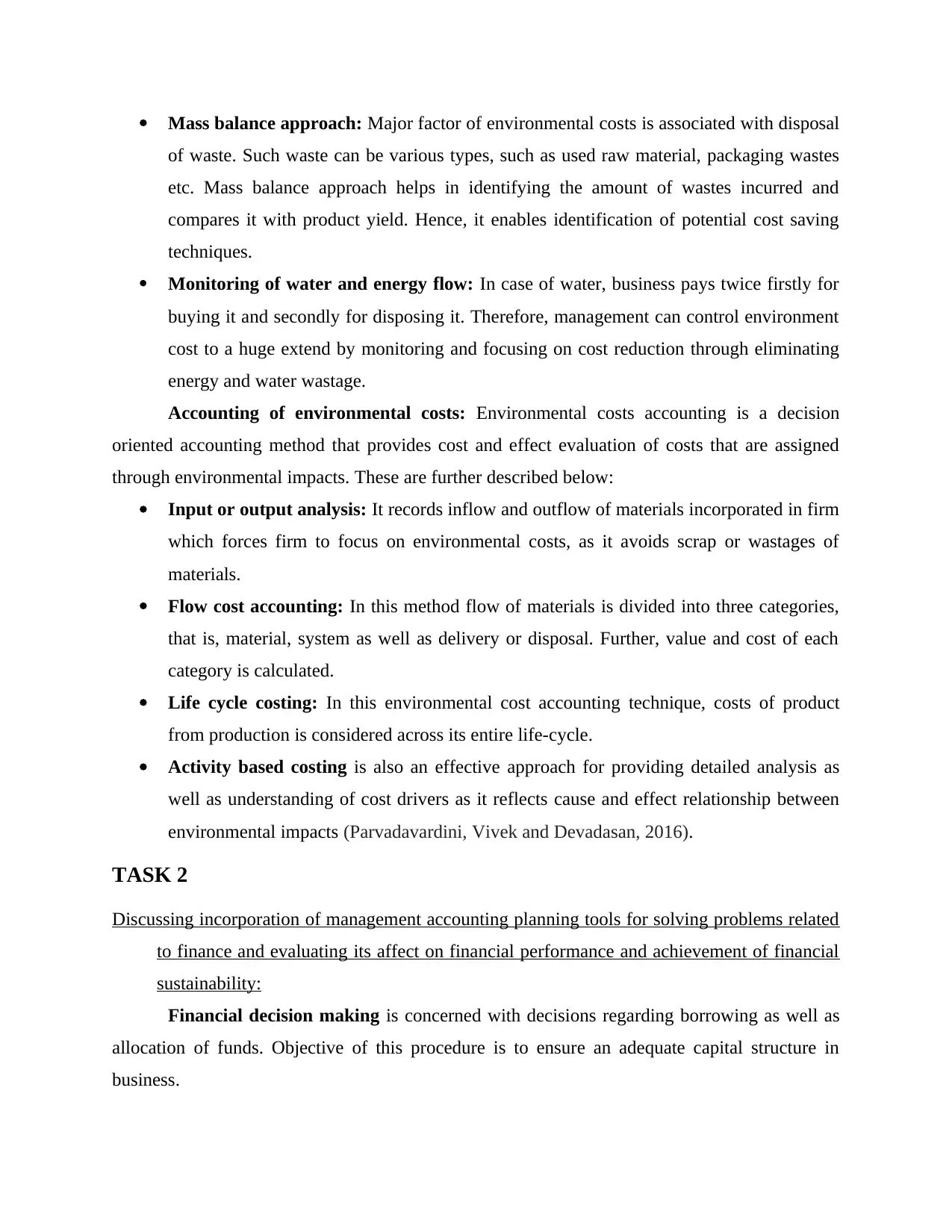
Mass balance approach: Major factor of environmental costs is associated with disposal
of waste. Such waste can be various types, such as used raw material, packaging wastes
etc. Mass balance approach helps in identifying the amount of wastes incurred and
compares it with product yield. Hence, it enables identification of potential cost saving
techniques.
Monitoring of water and energy flow: In case of water, business pays twice firstly for
buying it and secondly for disposing it. Therefore, management can control environment
cost to a huge extend by monitoring and focusing on cost reduction through eliminating
energy and water wastage.
Accounting of environmental costs: Environmental costs accounting is a decision
oriented accounting method that provides cost and effect evaluation of costs that are assigned
through environmental impacts. These are further described below:
Input or output analysis: It records inflow and outflow of materials incorporated in firm
which forces firm to focus on environmental costs, as it avoids scrap or wastages of
materials.
Flow cost accounting: In this method flow of materials is divided into three categories,
that is, material, system as well as delivery or disposal. Further, value and cost of each
category is calculated.
Life cycle costing: In this environmental cost accounting technique, costs of product
from production is considered across its entire life-cycle.
Activity based costing is also an effective approach for providing detailed analysis as
well as understanding of cost drivers as it reflects cause and effect relationship between
environmental impacts (Parvadavardini, Vivek and Devadasan, 2016).
TASK 2
Discussing incorporation of management accounting planning tools for solving problems related
to finance and evaluating its affect on financial performance and achievement of financial
sustainability:
Financial decision making is concerned with decisions regarding borrowing as well as
allocation of funds. Objective of this procedure is to ensure an adequate capital structure in
business.
of waste. Such waste can be various types, such as used raw material, packaging wastes
etc. Mass balance approach helps in identifying the amount of wastes incurred and
compares it with product yield. Hence, it enables identification of potential cost saving
techniques.
Monitoring of water and energy flow: In case of water, business pays twice firstly for
buying it and secondly for disposing it. Therefore, management can control environment
cost to a huge extend by monitoring and focusing on cost reduction through eliminating
energy and water wastage.
Accounting of environmental costs: Environmental costs accounting is a decision
oriented accounting method that provides cost and effect evaluation of costs that are assigned
through environmental impacts. These are further described below:
Input or output analysis: It records inflow and outflow of materials incorporated in firm
which forces firm to focus on environmental costs, as it avoids scrap or wastages of
materials.
Flow cost accounting: In this method flow of materials is divided into three categories,
that is, material, system as well as delivery or disposal. Further, value and cost of each
category is calculated.
Life cycle costing: In this environmental cost accounting technique, costs of product
from production is considered across its entire life-cycle.
Activity based costing is also an effective approach for providing detailed analysis as
well as understanding of cost drivers as it reflects cause and effect relationship between
environmental impacts (Parvadavardini, Vivek and Devadasan, 2016).
TASK 2
Discussing incorporation of management accounting planning tools for solving problems related
to finance and evaluating its affect on financial performance and achievement of financial
sustainability:
Financial decision making is concerned with decisions regarding borrowing as well as
allocation of funds. Objective of this procedure is to ensure an adequate capital structure in
business.
⊘ This is a preview!⊘
Do you want full access?
Subscribe today to unlock all pages.

Trusted by 1+ million students worldwide
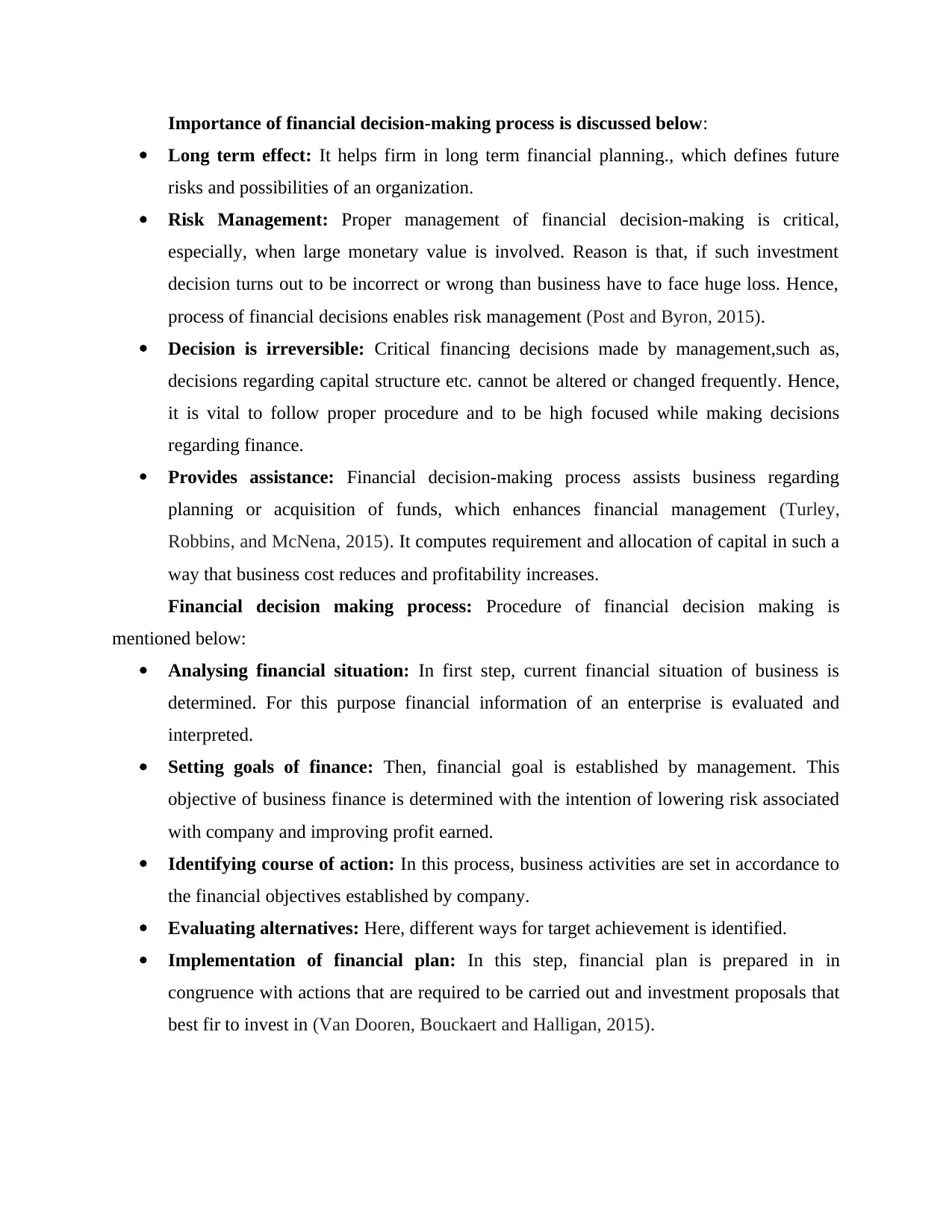
Importance of financial decision-making process is discussed below:
Long term effect: It helps firm in long term financial planning., which defines future
risks and possibilities of an organization.
Risk Management: Proper management of financial decision-making is critical,
especially, when large monetary value is involved. Reason is that, if such investment
decision turns out to be incorrect or wrong than business have to face huge loss. Hence,
process of financial decisions enables risk management (Post and Byron, 2015).
Decision is irreversible: Critical financing decisions made by management,such as,
decisions regarding capital structure etc. cannot be altered or changed frequently. Hence,
it is vital to follow proper procedure and to be high focused while making decisions
regarding finance.
Provides assistance: Financial decision-making process assists business regarding
planning or acquisition of funds, which enhances financial management (Turley,
Robbins, and McNena, 2015). It computes requirement and allocation of capital in such a
way that business cost reduces and profitability increases.
Financial decision making process: Procedure of financial decision making is
mentioned below:
Analysing financial situation: In first step, current financial situation of business is
determined. For this purpose financial information of an enterprise is evaluated and
interpreted.
Setting goals of finance: Then, financial goal is established by management. This
objective of business finance is determined with the intention of lowering risk associated
with company and improving profit earned.
Identifying course of action: In this process, business activities are set in accordance to
the financial objectives established by company.
Evaluating alternatives: Here, different ways for target achievement is identified.
Implementation of financial plan: In this step, financial plan is prepared in in
congruence with actions that are required to be carried out and investment proposals that
best fir to invest in (Van Dooren, Bouckaert and Halligan, 2015).
Long term effect: It helps firm in long term financial planning., which defines future
risks and possibilities of an organization.
Risk Management: Proper management of financial decision-making is critical,
especially, when large monetary value is involved. Reason is that, if such investment
decision turns out to be incorrect or wrong than business have to face huge loss. Hence,
process of financial decisions enables risk management (Post and Byron, 2015).
Decision is irreversible: Critical financing decisions made by management,such as,
decisions regarding capital structure etc. cannot be altered or changed frequently. Hence,
it is vital to follow proper procedure and to be high focused while making decisions
regarding finance.
Provides assistance: Financial decision-making process assists business regarding
planning or acquisition of funds, which enhances financial management (Turley,
Robbins, and McNena, 2015). It computes requirement and allocation of capital in such a
way that business cost reduces and profitability increases.
Financial decision making process: Procedure of financial decision making is
mentioned below:
Analysing financial situation: In first step, current financial situation of business is
determined. For this purpose financial information of an enterprise is evaluated and
interpreted.
Setting goals of finance: Then, financial goal is established by management. This
objective of business finance is determined with the intention of lowering risk associated
with company and improving profit earned.
Identifying course of action: In this process, business activities are set in accordance to
the financial objectives established by company.
Evaluating alternatives: Here, different ways for target achievement is identified.
Implementation of financial plan: In this step, financial plan is prepared in in
congruence with actions that are required to be carried out and investment proposals that
best fir to invest in (Van Dooren, Bouckaert and Halligan, 2015).
Paraphrase This Document
Need a fresh take? Get an instant paraphrase of this document with our AI Paraphraser
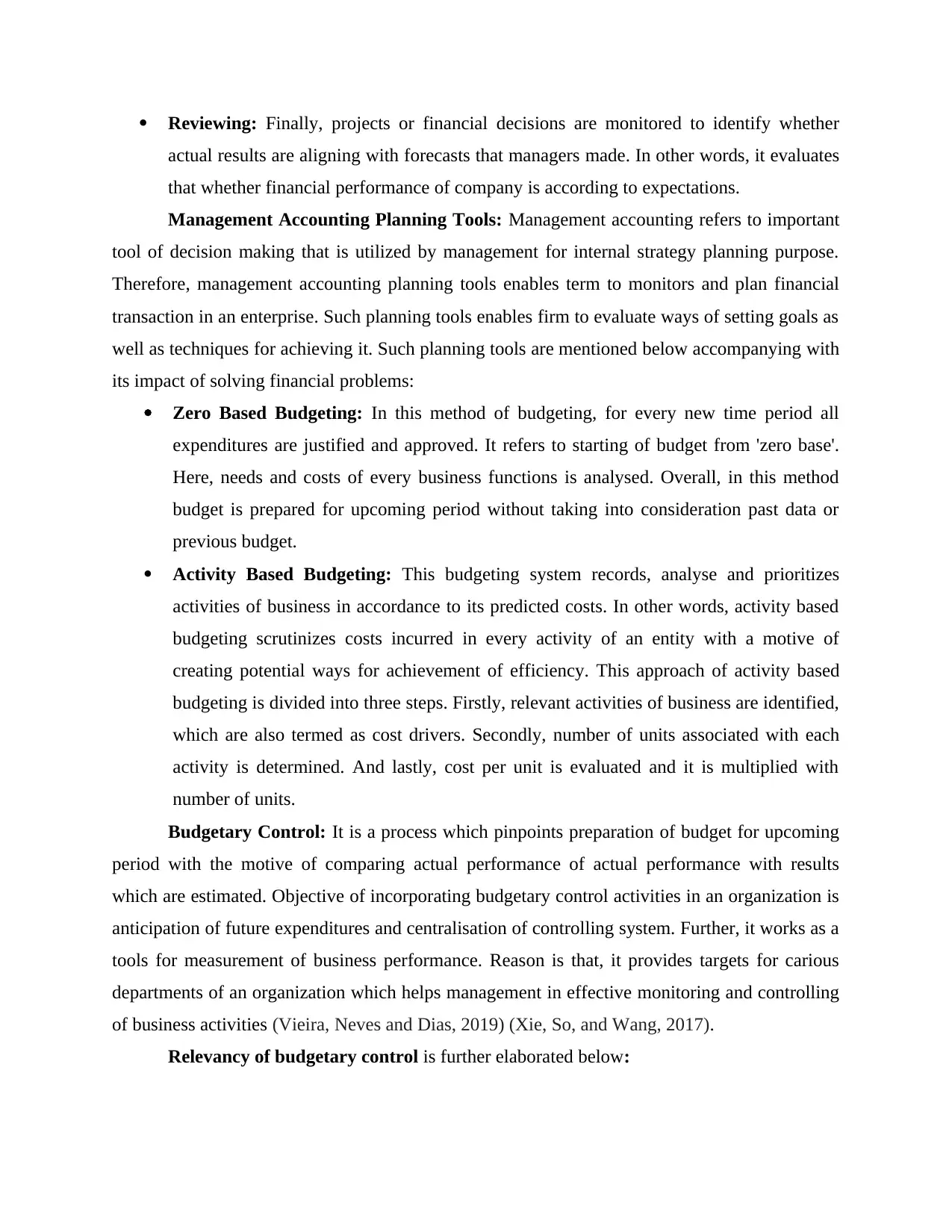
Reviewing: Finally, projects or financial decisions are monitored to identify whether
actual results are aligning with forecasts that managers made. In other words, it evaluates
that whether financial performance of company is according to expectations.
Management Accounting Planning Tools: Management accounting refers to important
tool of decision making that is utilized by management for internal strategy planning purpose.
Therefore, management accounting planning tools enables term to monitors and plan financial
transaction in an enterprise. Such planning tools enables firm to evaluate ways of setting goals as
well as techniques for achieving it. Such planning tools are mentioned below accompanying with
its impact of solving financial problems:
Zero Based Budgeting: In this method of budgeting, for every new time period all
expenditures are justified and approved. It refers to starting of budget from 'zero base'.
Here, needs and costs of every business functions is analysed. Overall, in this method
budget is prepared for upcoming period without taking into consideration past data or
previous budget.
Activity Based Budgeting: This budgeting system records, analyse and prioritizes
activities of business in accordance to its predicted costs. In other words, activity based
budgeting scrutinizes costs incurred in every activity of an entity with a motive of
creating potential ways for achievement of efficiency. This approach of activity based
budgeting is divided into three steps. Firstly, relevant activities of business are identified,
which are also termed as cost drivers. Secondly, number of units associated with each
activity is determined. And lastly, cost per unit is evaluated and it is multiplied with
number of units.
Budgetary Control: It is a process which pinpoints preparation of budget for upcoming
period with the motive of comparing actual performance of actual performance with results
which are estimated. Objective of incorporating budgetary control activities in an organization is
anticipation of future expenditures and centralisation of controlling system. Further, it works as a
tools for measurement of business performance. Reason is that, it provides targets for carious
departments of an organization which helps management in effective monitoring and controlling
of business activities (Vieira, Neves and Dias, 2019) (Xie, So, and Wang, 2017).
Relevancy of budgetary control is further elaborated below:
actual results are aligning with forecasts that managers made. In other words, it evaluates
that whether financial performance of company is according to expectations.
Management Accounting Planning Tools: Management accounting refers to important
tool of decision making that is utilized by management for internal strategy planning purpose.
Therefore, management accounting planning tools enables term to monitors and plan financial
transaction in an enterprise. Such planning tools enables firm to evaluate ways of setting goals as
well as techniques for achieving it. Such planning tools are mentioned below accompanying with
its impact of solving financial problems:
Zero Based Budgeting: In this method of budgeting, for every new time period all
expenditures are justified and approved. It refers to starting of budget from 'zero base'.
Here, needs and costs of every business functions is analysed. Overall, in this method
budget is prepared for upcoming period without taking into consideration past data or
previous budget.
Activity Based Budgeting: This budgeting system records, analyse and prioritizes
activities of business in accordance to its predicted costs. In other words, activity based
budgeting scrutinizes costs incurred in every activity of an entity with a motive of
creating potential ways for achievement of efficiency. This approach of activity based
budgeting is divided into three steps. Firstly, relevant activities of business are identified,
which are also termed as cost drivers. Secondly, number of units associated with each
activity is determined. And lastly, cost per unit is evaluated and it is multiplied with
number of units.
Budgetary Control: It is a process which pinpoints preparation of budget for upcoming
period with the motive of comparing actual performance of actual performance with results
which are estimated. Objective of incorporating budgetary control activities in an organization is
anticipation of future expenditures and centralisation of controlling system. Further, it works as a
tools for measurement of business performance. Reason is that, it provides targets for carious
departments of an organization which helps management in effective monitoring and controlling
of business activities (Vieira, Neves and Dias, 2019) (Xie, So, and Wang, 2017).
Relevancy of budgetary control is further elaborated below:
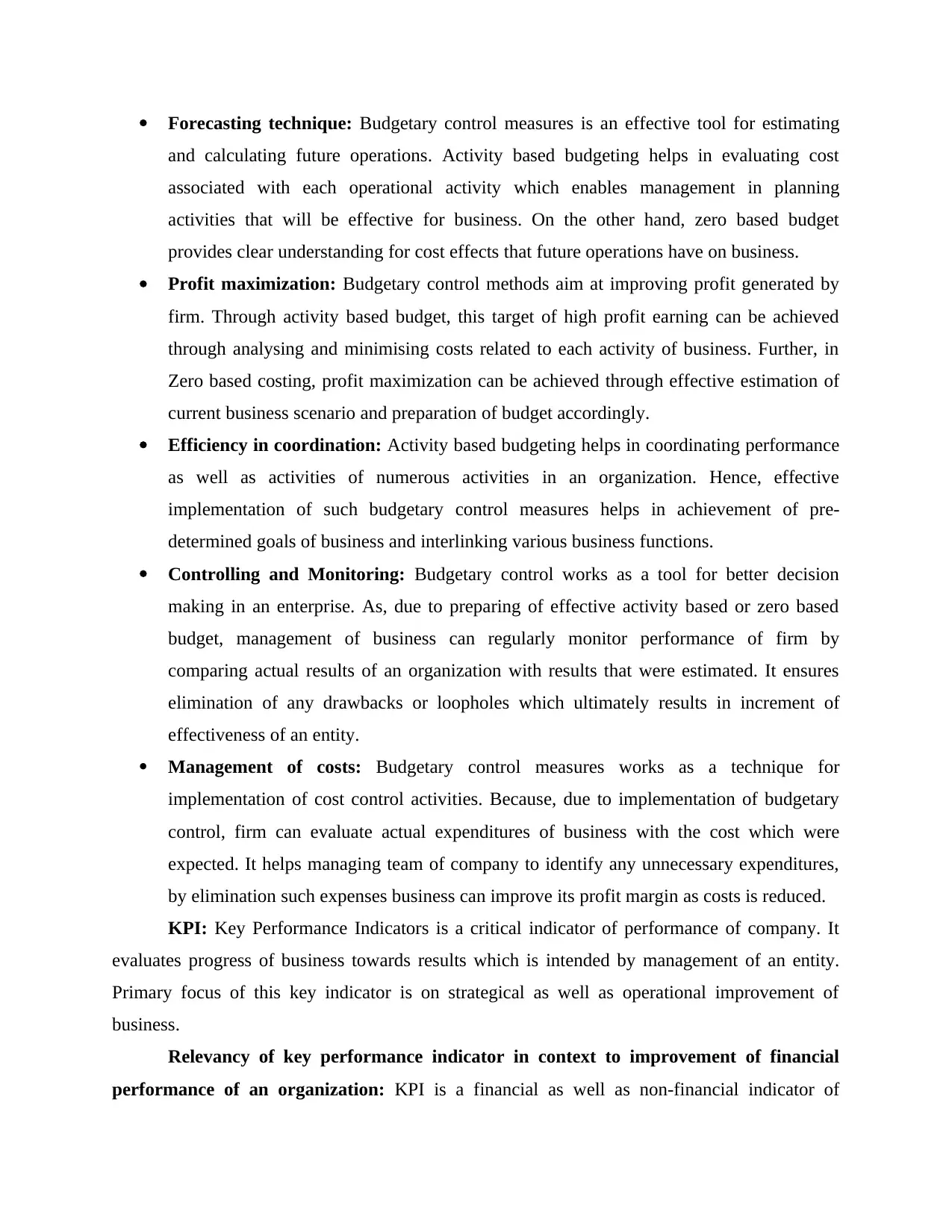
Forecasting technique: Budgetary control measures is an effective tool for estimating
and calculating future operations. Activity based budgeting helps in evaluating cost
associated with each operational activity which enables management in planning
activities that will be effective for business. On the other hand, zero based budget
provides clear understanding for cost effects that future operations have on business.
Profit maximization: Budgetary control methods aim at improving profit generated by
firm. Through activity based budget, this target of high profit earning can be achieved
through analysing and minimising costs related to each activity of business. Further, in
Zero based costing, profit maximization can be achieved through effective estimation of
current business scenario and preparation of budget accordingly.
Efficiency in coordination: Activity based budgeting helps in coordinating performance
as well as activities of numerous activities in an organization. Hence, effective
implementation of such budgetary control measures helps in achievement of pre-
determined goals of business and interlinking various business functions.
Controlling and Monitoring: Budgetary control works as a tool for better decision
making in an enterprise. As, due to preparing of effective activity based or zero based
budget, management of business can regularly monitor performance of firm by
comparing actual results of an organization with results that were estimated. It ensures
elimination of any drawbacks or loopholes which ultimately results in increment of
effectiveness of an entity.
Management of costs: Budgetary control measures works as a technique for
implementation of cost control activities. Because, due to implementation of budgetary
control, firm can evaluate actual expenditures of business with the cost which were
expected. It helps managing team of company to identify any unnecessary expenditures,
by elimination such expenses business can improve its profit margin as costs is reduced.
KPI: Key Performance Indicators is a critical indicator of performance of company. It
evaluates progress of business towards results which is intended by management of an entity.
Primary focus of this key indicator is on strategical as well as operational improvement of
business.
Relevancy of key performance indicator in context to improvement of financial
performance of an organization: KPI is a financial as well as non-financial indicator of
and calculating future operations. Activity based budgeting helps in evaluating cost
associated with each operational activity which enables management in planning
activities that will be effective for business. On the other hand, zero based budget
provides clear understanding for cost effects that future operations have on business.
Profit maximization: Budgetary control methods aim at improving profit generated by
firm. Through activity based budget, this target of high profit earning can be achieved
through analysing and minimising costs related to each activity of business. Further, in
Zero based costing, profit maximization can be achieved through effective estimation of
current business scenario and preparation of budget accordingly.
Efficiency in coordination: Activity based budgeting helps in coordinating performance
as well as activities of numerous activities in an organization. Hence, effective
implementation of such budgetary control measures helps in achievement of pre-
determined goals of business and interlinking various business functions.
Controlling and Monitoring: Budgetary control works as a tool for better decision
making in an enterprise. As, due to preparing of effective activity based or zero based
budget, management of business can regularly monitor performance of firm by
comparing actual results of an organization with results that were estimated. It ensures
elimination of any drawbacks or loopholes which ultimately results in increment of
effectiveness of an entity.
Management of costs: Budgetary control measures works as a technique for
implementation of cost control activities. Because, due to implementation of budgetary
control, firm can evaluate actual expenditures of business with the cost which were
expected. It helps managing team of company to identify any unnecessary expenditures,
by elimination such expenses business can improve its profit margin as costs is reduced.
KPI: Key Performance Indicators is a critical indicator of performance of company. It
evaluates progress of business towards results which is intended by management of an entity.
Primary focus of this key indicator is on strategical as well as operational improvement of
business.
Relevancy of key performance indicator in context to improvement of financial
performance of an organization: KPI is a financial as well as non-financial indicator of
⊘ This is a preview!⊘
Do you want full access?
Subscribe today to unlock all pages.

Trusted by 1+ million students worldwide
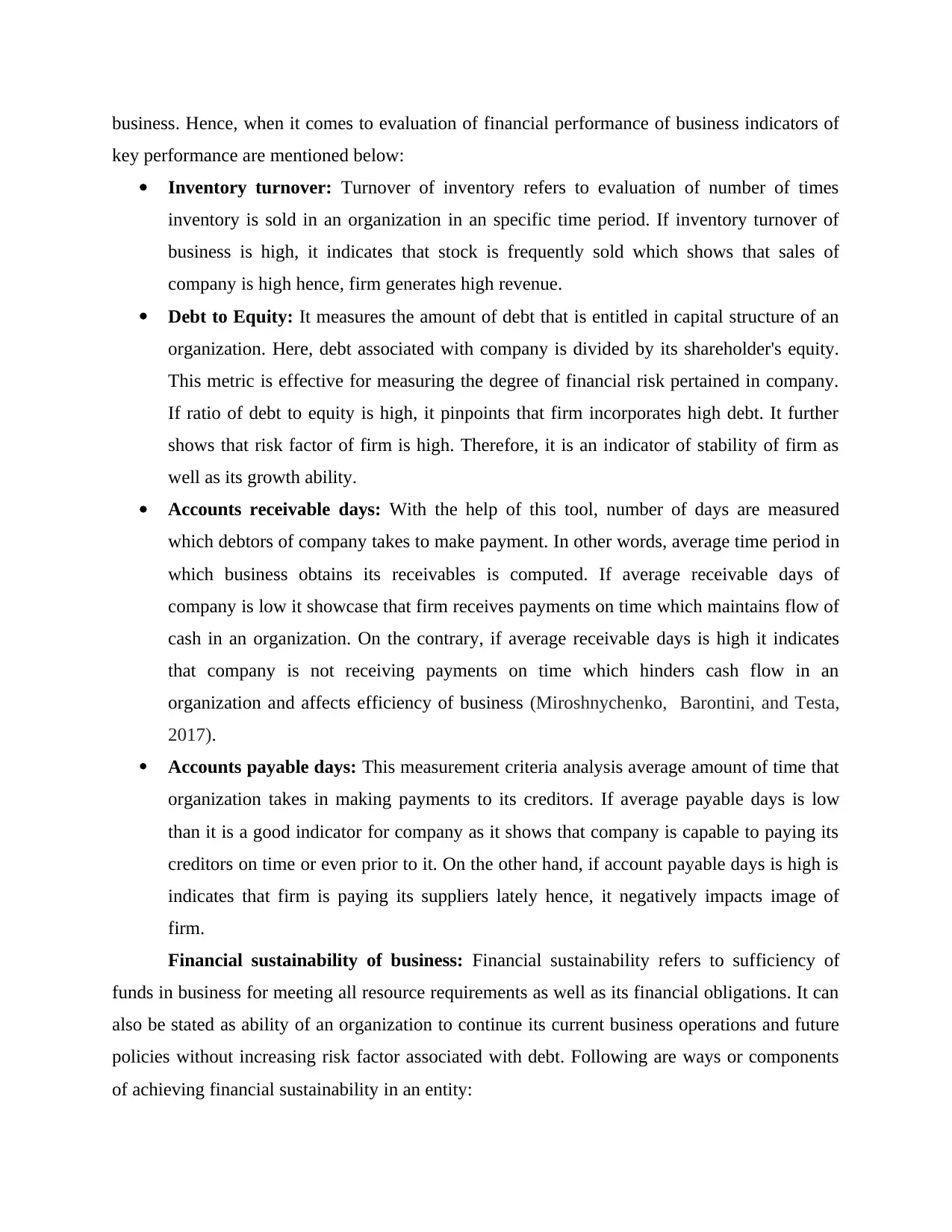
business. Hence, when it comes to evaluation of financial performance of business indicators of
key performance are mentioned below:
Inventory turnover: Turnover of inventory refers to evaluation of number of times
inventory is sold in an organization in an specific time period. If inventory turnover of
business is high, it indicates that stock is frequently sold which shows that sales of
company is high hence, firm generates high revenue.
Debt to Equity: It measures the amount of debt that is entitled in capital structure of an
organization. Here, debt associated with company is divided by its shareholder's equity.
This metric is effective for measuring the degree of financial risk pertained in company.
If ratio of debt to equity is high, it pinpoints that firm incorporates high debt. It further
shows that risk factor of firm is high. Therefore, it is an indicator of stability of firm as
well as its growth ability.
Accounts receivable days: With the help of this tool, number of days are measured
which debtors of company takes to make payment. In other words, average time period in
which business obtains its receivables is computed. If average receivable days of
company is low it showcase that firm receives payments on time which maintains flow of
cash in an organization. On the contrary, if average receivable days is high it indicates
that company is not receiving payments on time which hinders cash flow in an
organization and affects efficiency of business (Miroshnychenko, Barontini, and Testa,
2017).
Accounts payable days: This measurement criteria analysis average amount of time that
organization takes in making payments to its creditors. If average payable days is low
than it is a good indicator for company as it shows that company is capable to paying its
creditors on time or even prior to it. On the other hand, if account payable days is high is
indicates that firm is paying its suppliers lately hence, it negatively impacts image of
firm.
Financial sustainability of business: Financial sustainability refers to sufficiency of
funds in business for meeting all resource requirements as well as its financial obligations. It can
also be stated as ability of an organization to continue its current business operations and future
policies without increasing risk factor associated with debt. Following are ways or components
of achieving financial sustainability in an entity:
key performance are mentioned below:
Inventory turnover: Turnover of inventory refers to evaluation of number of times
inventory is sold in an organization in an specific time period. If inventory turnover of
business is high, it indicates that stock is frequently sold which shows that sales of
company is high hence, firm generates high revenue.
Debt to Equity: It measures the amount of debt that is entitled in capital structure of an
organization. Here, debt associated with company is divided by its shareholder's equity.
This metric is effective for measuring the degree of financial risk pertained in company.
If ratio of debt to equity is high, it pinpoints that firm incorporates high debt. It further
shows that risk factor of firm is high. Therefore, it is an indicator of stability of firm as
well as its growth ability.
Accounts receivable days: With the help of this tool, number of days are measured
which debtors of company takes to make payment. In other words, average time period in
which business obtains its receivables is computed. If average receivable days of
company is low it showcase that firm receives payments on time which maintains flow of
cash in an organization. On the contrary, if average receivable days is high it indicates
that company is not receiving payments on time which hinders cash flow in an
organization and affects efficiency of business (Miroshnychenko, Barontini, and Testa,
2017).
Accounts payable days: This measurement criteria analysis average amount of time that
organization takes in making payments to its creditors. If average payable days is low
than it is a good indicator for company as it shows that company is capable to paying its
creditors on time or even prior to it. On the other hand, if account payable days is high is
indicates that firm is paying its suppliers lately hence, it negatively impacts image of
firm.
Financial sustainability of business: Financial sustainability refers to sufficiency of
funds in business for meeting all resource requirements as well as its financial obligations. It can
also be stated as ability of an organization to continue its current business operations and future
policies without increasing risk factor associated with debt. Following are ways or components
of achieving financial sustainability in an entity:
Paraphrase This Document
Need a fresh take? Get an instant paraphrase of this document with our AI Paraphraser
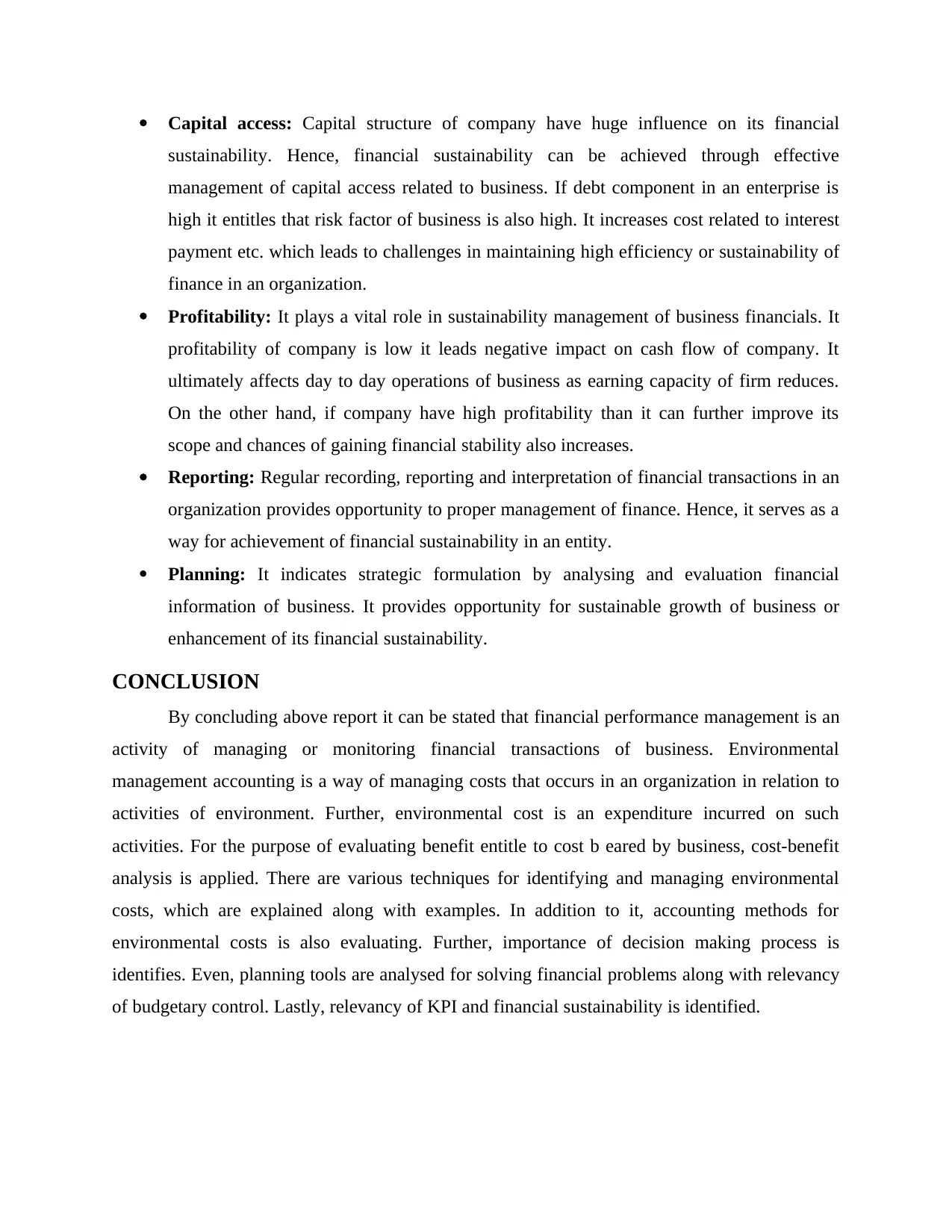
Capital access: Capital structure of company have huge influence on its financial
sustainability. Hence, financial sustainability can be achieved through effective
management of capital access related to business. If debt component in an enterprise is
high it entitles that risk factor of business is also high. It increases cost related to interest
payment etc. which leads to challenges in maintaining high efficiency or sustainability of
finance in an organization.
Profitability: It plays a vital role in sustainability management of business financials. It
profitability of company is low it leads negative impact on cash flow of company. It
ultimately affects day to day operations of business as earning capacity of firm reduces.
On the other hand, if company have high profitability than it can further improve its
scope and chances of gaining financial stability also increases.
Reporting: Regular recording, reporting and interpretation of financial transactions in an
organization provides opportunity to proper management of finance. Hence, it serves as a
way for achievement of financial sustainability in an entity.
Planning: It indicates strategic formulation by analysing and evaluation financial
information of business. It provides opportunity for sustainable growth of business or
enhancement of its financial sustainability.
CONCLUSION
By concluding above report it can be stated that financial performance management is an
activity of managing or monitoring financial transactions of business. Environmental
management accounting is a way of managing costs that occurs in an organization in relation to
activities of environment. Further, environmental cost is an expenditure incurred on such
activities. For the purpose of evaluating benefit entitle to cost b eared by business, cost-benefit
analysis is applied. There are various techniques for identifying and managing environmental
costs, which are explained along with examples. In addition to it, accounting methods for
environmental costs is also evaluating. Further, importance of decision making process is
identifies. Even, planning tools are analysed for solving financial problems along with relevancy
of budgetary control. Lastly, relevancy of KPI and financial sustainability is identified.
sustainability. Hence, financial sustainability can be achieved through effective
management of capital access related to business. If debt component in an enterprise is
high it entitles that risk factor of business is also high. It increases cost related to interest
payment etc. which leads to challenges in maintaining high efficiency or sustainability of
finance in an organization.
Profitability: It plays a vital role in sustainability management of business financials. It
profitability of company is low it leads negative impact on cash flow of company. It
ultimately affects day to day operations of business as earning capacity of firm reduces.
On the other hand, if company have high profitability than it can further improve its
scope and chances of gaining financial stability also increases.
Reporting: Regular recording, reporting and interpretation of financial transactions in an
organization provides opportunity to proper management of finance. Hence, it serves as a
way for achievement of financial sustainability in an entity.
Planning: It indicates strategic formulation by analysing and evaluation financial
information of business. It provides opportunity for sustainable growth of business or
enhancement of its financial sustainability.
CONCLUSION
By concluding above report it can be stated that financial performance management is an
activity of managing or monitoring financial transactions of business. Environmental
management accounting is a way of managing costs that occurs in an organization in relation to
activities of environment. Further, environmental cost is an expenditure incurred on such
activities. For the purpose of evaluating benefit entitle to cost b eared by business, cost-benefit
analysis is applied. There are various techniques for identifying and managing environmental
costs, which are explained along with examples. In addition to it, accounting methods for
environmental costs is also evaluating. Further, importance of decision making process is
identifies. Even, planning tools are analysed for solving financial problems along with relevancy
of budgetary control. Lastly, relevancy of KPI and financial sustainability is identified.
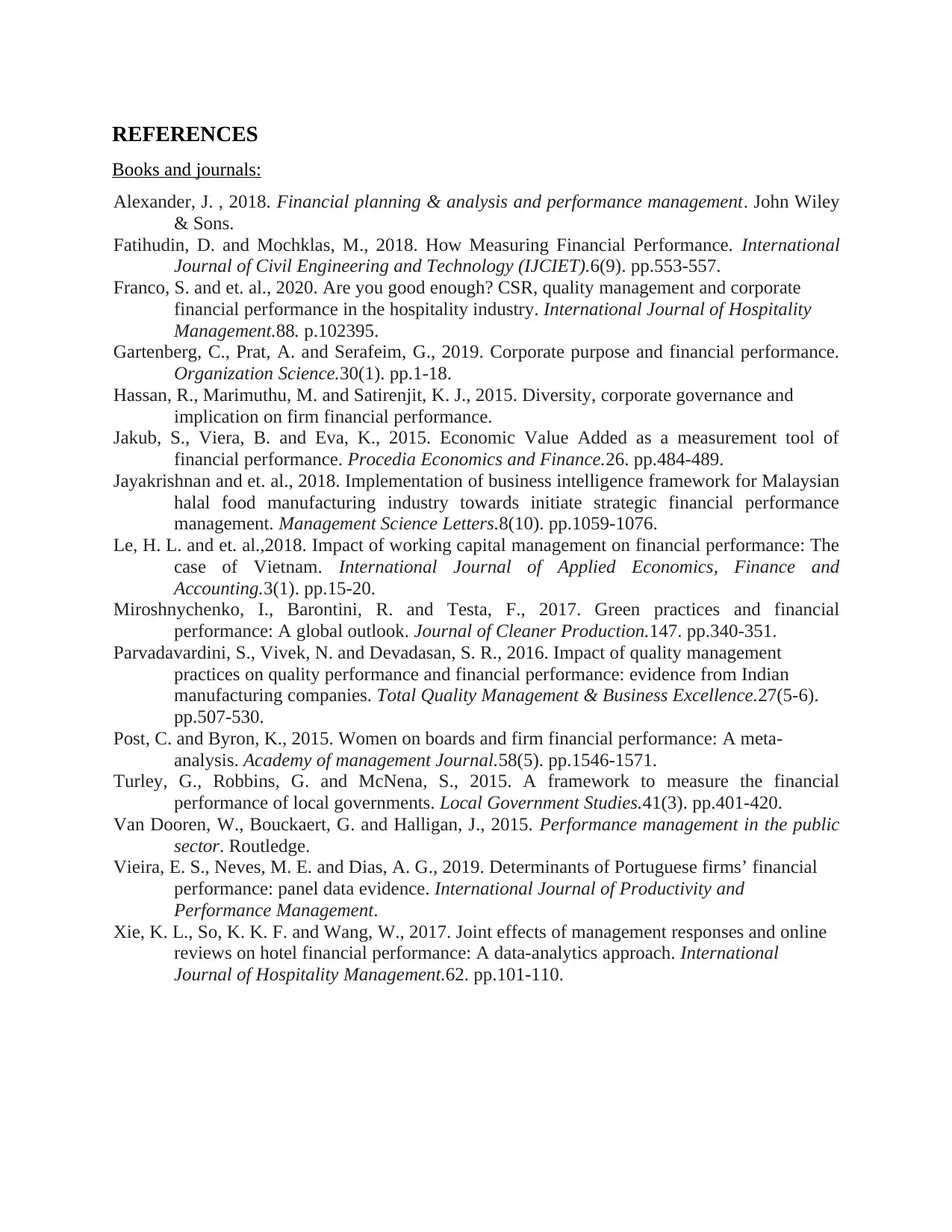
REFERENCES
Books and journals:
Alexander, J. , 2018. Financial planning & analysis and performance management. John Wiley
& Sons.
Fatihudin, D. and Mochklas, M., 2018. How Measuring Financial Performance. International
Journal of Civil Engineering and Technology (IJCIET).6(9). pp.553-557.
Franco, S. and et. al., 2020. Are you good enough? CSR, quality management and corporate
financial performance in the hospitality industry. International Journal of Hospitality
Management.88. p.102395.
Gartenberg, C., Prat, A. and Serafeim, G., 2019. Corporate purpose and financial performance.
Organization Science.30(1). pp.1-18.
Hassan, R., Marimuthu, M. and Satirenjit, K. J., 2015. Diversity, corporate governance and
implication on firm financial performance.
Jakub, S., Viera, B. and Eva, K., 2015. Economic Value Added as a measurement tool of
financial performance. Procedia Economics and Finance.26. pp.484-489.
Jayakrishnan and et. al., 2018. Implementation of business intelligence framework for Malaysian
halal food manufacturing industry towards initiate strategic financial performance
management. Management Science Letters.8(10). pp.1059-1076.
Le, H. L. and et. al.,2018. Impact of working capital management on financial performance: The
case of Vietnam. International Journal of Applied Economics, Finance and
Accounting.3(1). pp.15-20.
Miroshnychenko, I., Barontini, R. and Testa, F., 2017. Green practices and financial
performance: A global outlook. Journal of Cleaner Production.147. pp.340-351.
Parvadavardini, S., Vivek, N. and Devadasan, S. R., 2016. Impact of quality management
practices on quality performance and financial performance: evidence from Indian
manufacturing companies. Total Quality Management & Business Excellence.27(5-6).
pp.507-530.
Post, C. and Byron, K., 2015. Women on boards and firm financial performance: A meta-
analysis. Academy of management Journal.58(5). pp.1546-1571.
Turley, G., Robbins, G. and McNena, S., 2015. A framework to measure the financial
performance of local governments. Local Government Studies.41(3). pp.401-420.
Van Dooren, W., Bouckaert, G. and Halligan, J., 2015. Performance management in the public
sector. Routledge.
Vieira, E. S., Neves, M. E. and Dias, A. G., 2019. Determinants of Portuguese firms’ financial
performance: panel data evidence. International Journal of Productivity and
Performance Management.
Xie, K. L., So, K. K. F. and Wang, W., 2017. Joint effects of management responses and online
reviews on hotel financial performance: A data-analytics approach. International
Journal of Hospitality Management.62. pp.101-110.
Books and journals:
Alexander, J. , 2018. Financial planning & analysis and performance management. John Wiley
& Sons.
Fatihudin, D. and Mochklas, M., 2018. How Measuring Financial Performance. International
Journal of Civil Engineering and Technology (IJCIET).6(9). pp.553-557.
Franco, S. and et. al., 2020. Are you good enough? CSR, quality management and corporate
financial performance in the hospitality industry. International Journal of Hospitality
Management.88. p.102395.
Gartenberg, C., Prat, A. and Serafeim, G., 2019. Corporate purpose and financial performance.
Organization Science.30(1). pp.1-18.
Hassan, R., Marimuthu, M. and Satirenjit, K. J., 2015. Diversity, corporate governance and
implication on firm financial performance.
Jakub, S., Viera, B. and Eva, K., 2015. Economic Value Added as a measurement tool of
financial performance. Procedia Economics and Finance.26. pp.484-489.
Jayakrishnan and et. al., 2018. Implementation of business intelligence framework for Malaysian
halal food manufacturing industry towards initiate strategic financial performance
management. Management Science Letters.8(10). pp.1059-1076.
Le, H. L. and et. al.,2018. Impact of working capital management on financial performance: The
case of Vietnam. International Journal of Applied Economics, Finance and
Accounting.3(1). pp.15-20.
Miroshnychenko, I., Barontini, R. and Testa, F., 2017. Green practices and financial
performance: A global outlook. Journal of Cleaner Production.147. pp.340-351.
Parvadavardini, S., Vivek, N. and Devadasan, S. R., 2016. Impact of quality management
practices on quality performance and financial performance: evidence from Indian
manufacturing companies. Total Quality Management & Business Excellence.27(5-6).
pp.507-530.
Post, C. and Byron, K., 2015. Women on boards and firm financial performance: A meta-
analysis. Academy of management Journal.58(5). pp.1546-1571.
Turley, G., Robbins, G. and McNena, S., 2015. A framework to measure the financial
performance of local governments. Local Government Studies.41(3). pp.401-420.
Van Dooren, W., Bouckaert, G. and Halligan, J., 2015. Performance management in the public
sector. Routledge.
Vieira, E. S., Neves, M. E. and Dias, A. G., 2019. Determinants of Portuguese firms’ financial
performance: panel data evidence. International Journal of Productivity and
Performance Management.
Xie, K. L., So, K. K. F. and Wang, W., 2017. Joint effects of management responses and online
reviews on hotel financial performance: A data-analytics approach. International
Journal of Hospitality Management.62. pp.101-110.
⊘ This is a preview!⊘
Do you want full access?
Subscribe today to unlock all pages.

Trusted by 1+ million students worldwide
1 out of 13
Related Documents
Your All-in-One AI-Powered Toolkit for Academic Success.
+13062052269
info@desklib.com
Available 24*7 on WhatsApp / Email
![[object Object]](/_next/static/media/star-bottom.7253800d.svg)
Unlock your academic potential
Copyright © 2020–2025 A2Z Services. All Rights Reserved. Developed and managed by ZUCOL.





